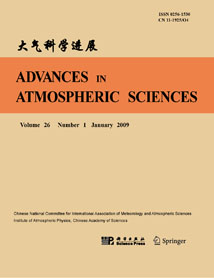| [1] |
ZHU Jiangshan, Fanyou KONG, LEI Hengchi,
2012: A Regional Ensemble Forecast System for Stratiform Precipitation Events in Northern China. Part I: A Case Study, ADVANCES IN ATMOSPHERIC SCIENCES, 29, 201-216.
doi: 10.1007/s00376-011-0137-1
|
| [2] |
MA Juhui, Yuejian ZHU, Richard WOBUS, Panxing WANG,
2012: An Effective Configuration of Ensemble Size and Horizontal Resolution for the NCEP GEFS, ADVANCES IN ATMOSPHERIC SCIENCES, 29, 782-794.
doi: 10.1007/s00376-012-1249-y
|
| [3] |
Zhaorong ZHUANG, Nusrat YUSSOUF, Jidong GAO,
2016: Analyses and Forecasts of a Tornadic Supercell Outbreak Using a 3DVAR System Ensemble, ADVANCES IN ATMOSPHERIC SCIENCES, 33, 544-558.
doi: 10.1007/s00376-015-5072-0
|
| [4] |
ZHOU Baiquan, NIU Ruoyun, ZHAI Panmao,
2015: An Assessment of the Predictability of the East Asian Subtropical Westerly Jet Based on TIGGE Data, ADVANCES IN ATMOSPHERIC SCIENCES, 32, 401-412.
doi: 10.1007/s00376-014-4026-2
|
| [5] |
FENG Yerong, David H. KITZMILLER,
2006: A Short-Range Quantitative Precipitation Forecast Algorithm Using Back-Propagation Neural Network Approach, ADVANCES IN ATMOSPHERIC SCIENCES, 23, 405-414.
doi: 10.1007/s00376-006-0405-7
|
| [6] |
Jiaqi Zheng, Qing Ling, Jia Li, Yerong Feng,
2023: Improving Short-Range Precipitation Forecast of Numerical Weather Prediction Through a Deep Learning-Based Mask Approach, ADVANCES IN ATMOSPHERIC SCIENCES.
doi: 10.1007/s00376-023-3085-7
|
| [7] |
Jiangshan ZHU, Fanyou KONG, Xiao-Ming HU, Yan GUO, Lingkun RAN, Hengchi LEI,
2018: Impact of Soil Moisture Uncertainty on Summertime Short-range Ensemble Forecasts, ADVANCES IN ATMOSPHERIC SCIENCES, 35, 839-852.
doi: 10.1007/s00376-017-7107-1
|
| [8] |
ZHU Jiang, LIN Caiyan, WANG Zifa,
2009: Dust Storm Ensemble Forecast Experiments in East Asia, ADVANCES IN ATMOSPHERIC SCIENCES, 26, 1053-1070.
doi: 10.1007/s00376-009-8218-0
|
| [9] |
Yuejian ZHU,
2005: Ensemble Forecast: A New Approach to Uncertainty and Predictability, ADVANCES IN ATMOSPHERIC SCIENCES, 22, 781-788.
doi: 10.1007/BF02918678
|
| [10] |
T. N. Krishnamurti, Mukul Tewari, Ed Bensman, Wei Han, Zhan Zhang, William K. M. Lau,
1999: An Ensemble Forecast of the South China Sea Monsoon, ADVANCES IN ATMOSPHERIC SCIENCES, 16, 159-182.
doi: 10.1007/BF02973080
|
| [11] |
Yang Fanglin, Yuan Chongguang,
1993: Numerical Simulation of Regional Short-Range Climate Anomalies, ADVANCES IN ATMOSPHERIC SCIENCES, 10, 335-344.
doi: 10.1007/BF02658139
|
| [12] |
T. N. KRISHNAMURTI, A. D. SAGADEVAN, A. CHAKRABORTY, A. K. MISHRA, A. SIMON,
2009: Improving Multimodel Weather Forecast of Monsoon Rain Over China Using FSU Superensemble, ADVANCES IN ATMOSPHERIC SCIENCES, 26, 813-839.
doi: 10.1007/s00376-009-8162-z
|
| [13] |
Guo DENG, Yuejian ZHU, Jiandong GONG, Dehui CHEN, Richard WOBUS, Zhe ZHANG,
2016: The Effects of Land Surface Process Perturbations in a Global Ensemble Forecast System, ADVANCES IN ATMOSPHERIC SCIENCES, 33, 1199-1208.
doi: 10.1007/s00376-016-6036-8
|
| [14] |
Lu YANG, Cong-Lan CHENG, Yu XIA, Min CHEN, Ming-Xuan CHEN, Han-Bin ZHANG, Xiang-Yu HUANG,
2023: Evaluation of the Added Value of Probabilistic Nowcasting Ensemble Forecasts on Regional Ensemble Forecasts, ADVANCES IN ATMOSPHERIC SCIENCES, 40, 937-951.
doi: 10.1007/s00376-022-2056-8
|
| [15] |
Sijia LI, Yuan WANG, Huiling YUAN, Jinjie SONG, Xin XU,
2016: Ensemble Mean Forecast Skill and Applications with the T213 Ensemble Prediction System, ADVANCES IN ATMOSPHERIC SCIENCES, 33, 1297-1305.
doi: 10.1007/s00376-016-6155-2
|
| [16] |
Liu Jianwen, Dong Peiming,
2001: Short-range Climate Prediction Experiment of the Southern Oscillation Index Based on the Singular Spectrum Analysis, ADVANCES IN ATMOSPHERIC SCIENCES, 18, 873-881.
|
| [17] |
Xiaohao QIN, Wansuo DUAN, Hui XU,
2020: Sensitivity to Tendency Perturbations of Tropical Cyclone Short-range Intensity Forecasts Generated by WRF, ADVANCES IN ATMOSPHERIC SCIENCES, 37, 291-306.
doi: 10.1007/s00376-019-9187-6
|
| [18] |
Jin FENG, Min CHEN, Yanjie LI, Jiqin ZHONG,
2021: An Implementation of Full Cycle Strategy Using Dynamic Blending for Rapid Refresh Short-range Weather Forecasting in China, ADVANCES IN ATMOSPHERIC SCIENCES, 38, 943-956.
doi: 10.1007/s00376-021-0316-7
|
| [19] |
Ni Yunqi, Zhang Qin, Li Yuedong,
1991: A Numerical Study of the Mechanism for the Effect of Northern Winter Arctic Ice Cover on the Global Short-Range Climate Evolution, ADVANCES IN ATMOSPHERIC SCIENCES, 8, 489-498.
doi: 10.1007/BF02919271
|
| [20] |
ZHENG Xiaogu, WU Guocan, ZHANG Shupeng, LIANG Xiao, DAI Yongjiu, LI Yong, ,
2013: Using Analysis State to Construct a Forecast Error Covariance Matrix in Ensemble Kalman Filter Assimilation, ADVANCES IN ATMOSPHERIC SCIENCES, 30, 1303-1312.
doi: 10.1007/s00376-012-2133-5
|















 AAS Website
AAS Website 
 AAS WeChat
AAS WeChat 
 DownLoad:
DownLoad: